Why Refugee Camps Adopt Lida Group’s Durable Temporary Prefab Buildings with High Quality Mobile House Amenities
2025-Aug-06 11:34:57
By Admin
1. Introduction
Refugee crises have become a pressing global issue, with millions of people displaced from their homes due to conflicts, natural disasters, and political instability. These displaced individuals often find themselves in refugee camps, where access to safe, comfortable, and functional shelter is a fundamental need. However, traditional shelter solutions in many refugee camps have long been inadequate, failing to meet the basic standards of living required for physical and mental well-being.
In recent years, there has been a significant shift towards adopting more innovative and reliable shelter solutions, and Lida Group’s durable temporary prefab buildings with high-quality mobile house amenities have emerged as a preferred choice for many refugee camps. This article explores the reasons behind this adoption, delving into the features, benefits, and impact of Lida Group‘s offerings in addressing the shelter challenges faced by refugee populations worldwide.
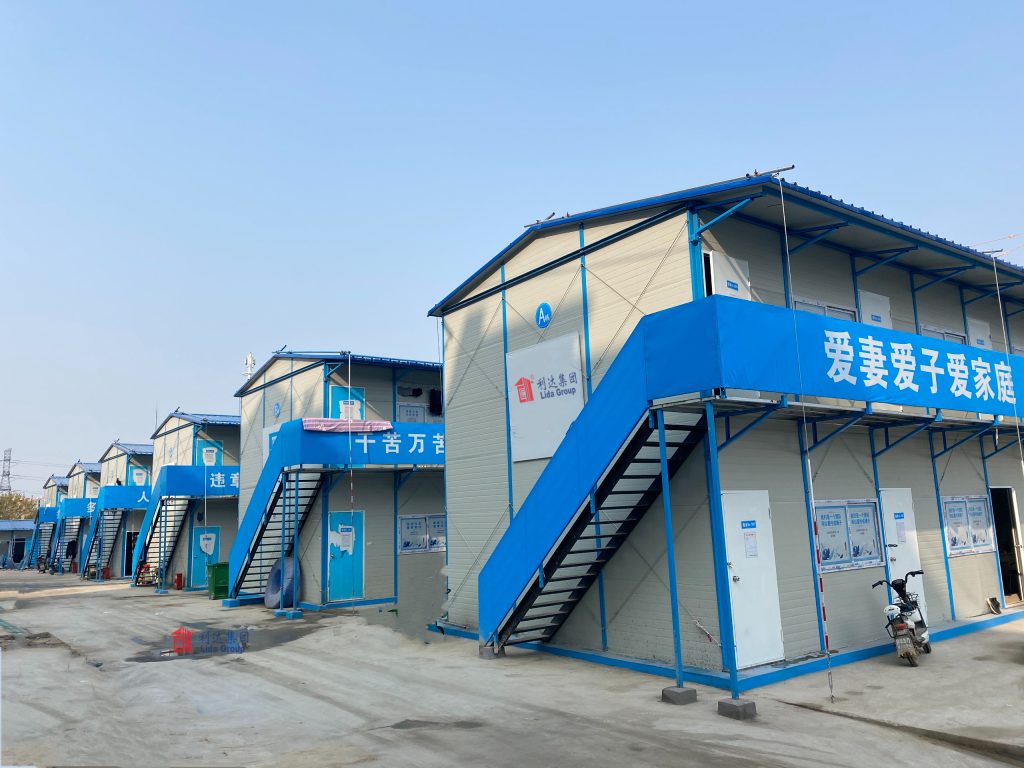
2. The Plight of Traditional Shelter in Refugee Camps
2.1 Inadequate Protection from the Elements
Traditional shelters in refugee camps, such as tents and makeshift huts, offer little protection against harsh weather conditions. In regions prone to heavy rain, these shelters often leak, leaving inhabitants exposed to dampness and cold, which can lead to a range of health issues, including respiratory infections and hypothermia. During hot seasons, tents provide minimal insulation, making the interior extremely hot and uncomfortable, increasing the risk of heat-related illnesses.
In areas affected by strong winds or sandstorms, tents are easily damaged or blown away, leaving refugees without any form of shelter. The lack of proper protection from the elements not only endangers the lives of refugees but also makes it difficult for them to maintain a sense of security and stability.
2.2 Poor Sanitation and Hygiene Conditions
Many traditional refugee shelters lack basic sanitation facilities, which is a major contributor to the spread of diseases. Overcrowding in camps, combined with inadequate toilets and washing facilities, leads to the contamination of water sources and the rapid spread of cholera, typhoid, and other waterborne diseases.
Makeshift shelters often have no proper drainage systems, resulting in stagnant water around the living areas, which becomes a breeding ground for mosquitoes and other pests, increasing the risk of malaria and dengue fever. The lack of privacy in these shelters also makes it difficult for refugees, especially women and children, to maintain personal hygiene, further compromising their health.
2.3 Lack of Durability and Short Lifespan
Tents and makeshift huts are designed to be temporary, but in many cases, refugees end up living in them for years. These shelters have a short lifespan, often deteriorating within a few months due to exposure to the elements and heavy use. The constant need for repair and replacement not only imposes a significant financial burden on aid organizations but also disrupts the lives of refugees, who have to repeatedly relocate or spend time and energy fixing their shelters.
The flimsy nature of these shelters also makes them vulnerable to damage from accidental fires, which can spread quickly in overcrowded camps, causing extensive loss of life and property.
2.4 Limited Space and Privacy
Overcrowding is a common problem in refugee camps, and traditional shelters offer very limited space. Families of multiple members are often forced to live in small tents or huts, with no separate areas for sleeping, cooking, or storing belongings. This lack of space leads to increased tension and conflict within families and communities.
Privacy is another major issue. Traditional shelters provide little to no privacy, making it difficult for refugees to carry out daily activities such as changing clothes, breastfeeding, or seeking medical attention in private. This lack of privacy has a negative impact on the mental health and dignity of refugees, particularly women and girls.
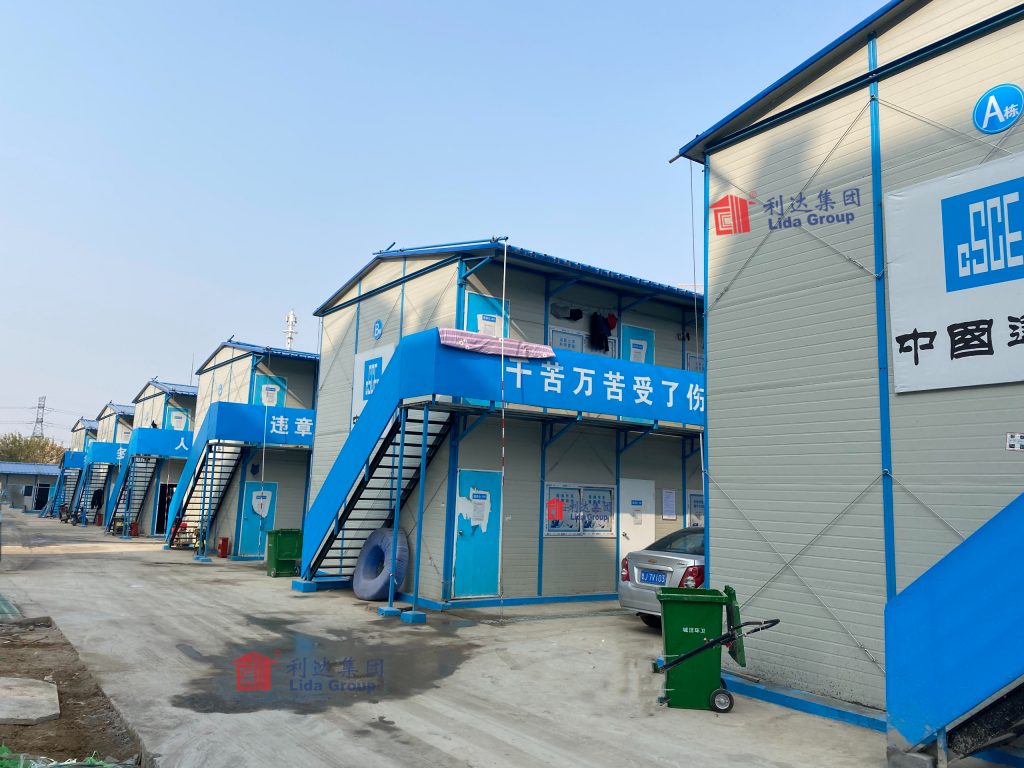
3. Lida Group’s Durable Temporary Prefab Buildings: Key Features
3.1 Robust Construction for Long-Term Use
Lida Group’s temporary prefab buildings are constructed using high-quality materials, including durable steel frames and insulated sandwich panels. These materials are designed to withstand harsh weather conditions, including strong winds, heavy rain, extreme temperatures, and sandstorms. The steel frames provide a strong and stable structure, ensuring that the buildings remain intact even in adverse conditions.
The insulated sandwich panels, which consist of an outer layer of metal, an inner layer of insulation material, and another layer of metal, offer excellent thermal insulation, protecting the interior from extreme heat and cold. This robust construction ensures that the buildings have a long lifespan, often lasting for 10 years or more, reducing the need for frequent replacement and providing a more stable living environment for refugees.
3.2 Modular Design for Flexibility and Scalability
One of the key features of Lida Group’s prefab buildings is their modular design. The buildings are composed of prefabricated modules that can be easily transported to the camp site and assembled quickly. This modular approach allows for great flexibility in terms of layout and size, enabling aid organizations to customize the shelters according to the specific needs of the refugee population.
Whether it’s a small family unit, a communal kitchen, a medical clinic, or a school, the modules can be combined in various configurations to create different types of spaces. This scalability is particularly important in refugee camps, where the number of inhabitants can fluctuate rapidly. Additional modules can be added as needed, ensuring that the shelter capacity can keep up with the demand.
3.3 Integration of Essential Amenities
Lida Group’s mobile houses are equipped with a range of high-quality amenities that are essential for a decent standard of living. These include proper ventilation systems to ensure fresh air circulation, windows that provide natural light, and electrical wiring for lighting and powering small appliances.
Many of the units also come with built-in sanitation facilities, such as toilets and showers, which are connected to a proper drainage system. This helps to improve hygiene conditions in the camp and reduce the spread of diseases. Some models even include kitchenettes with basic cooking facilities, allowing families to prepare their own meals, which is crucial for maintaining a sense of normalcy and nutrition.
3.4 Easy Transportation and Quick Installation
The prefabricated nature of Lida Group’s buildings makes them easy to transport. The modules are lightweight and can be loaded onto trucks, ships, or planes, making them accessible even to remote refugee camps. Once at the site, the installation process is quick and efficient, requiring minimal labor and equipment.
A team of trained technicians can assemble a single unit in a matter of hours, and an entire camp can be set up within a few days or weeks, depending on the size. This rapid deployment is vital in emergency situations, where refugees need shelter as soon as possible after displacement.
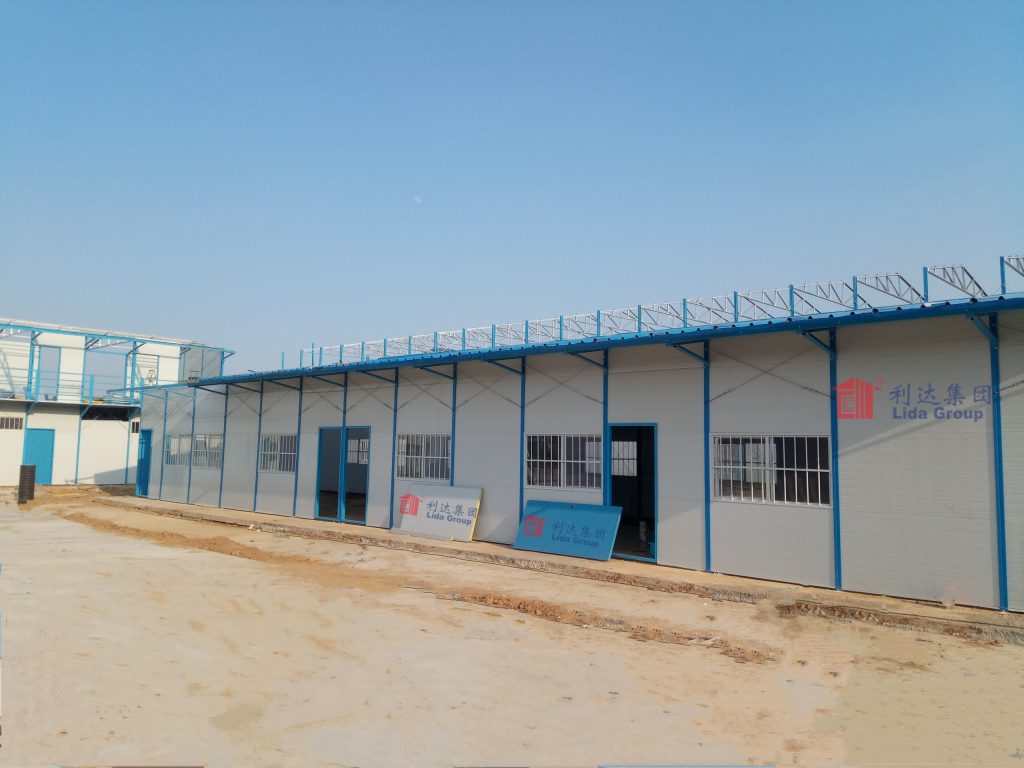
4. Benefits of Lida Group’s Solutions for Refugee Camps
4.1 Improved Health and Safety
The robust construction and integration of essential amenities in Lida Group’s buildings significantly improve the health and safety of refugees. The proper insulation protects against extreme temperatures, reducing the risk of heatstroke, hypothermia, and respiratory illnesses. The inclusion of sanitation facilities and proper drainage systems helps to prevent the spread of waterborne and vector-borne diseases, lowering the incidence of illness in the camp.
The durable structure also provides better protection against fires, as the materials used are fire-resistant. This reduces the risk of fire-related injuries and deaths, which are common in camps with traditional shelters.
4.2 Enhanced Dignity and Quality of Life
Having a safe, comfortable, and private space to live in has a profound impact on the dignity and quality of life of refugees. Lida Group’s mobile houses offer separate areas for sleeping, cooking, and personal hygiene, giving families a sense of normalcy and privacy. This helps to reduce stress and anxiety, improving mental health outcomes.
The availability of basic amenities such as electricity and cooking facilities allows refugees to carry out daily activities more easily, enabling them to maintain their cultural practices and routines. This sense of stability and control over their lives is crucial for the psychological well-being of displaced individuals, especially children, who need a secure environment to grow and develop.
4.3 Cost-Effectiveness in the Long Run
While the initial cost of Lida Group’s prefab buildings may be higher than that of traditional tents, they offer significant cost savings in the long run. The long lifespan of the buildings means that they do not need to be replaced as frequently, reducing the recurring costs associated with shelter provision.
The low maintenance requirements of the buildings also contribute to cost-effectiveness. The durable materials are resistant to wear and tear, and any repairs that are needed can be carried out quickly and easily using prefabricated components. Additionally, the energy efficiency of the insulated panels reduces the need for heating and cooling, lowering energy costs for the camp.
4.4 Support for Community Development
Lida Group’s prefab buildings are not just shelters; they can also serve as the foundation for community development in refugee camps. The modular design allows for the creation of communal spaces such as schools, clinics, community centers, and places of worship. These spaces play a vital role in bringing the community together, providing opportunities for education, healthcare, and social interaction.
Schools built using Lida Group’s modules enable children to continue their education, which is essential for their future prospects. Medical clinics provide access to healthcare services, improving the overall health of the community. Community centers serve as a hub for social activities, helping to build social cohesion and resilience among refugees.
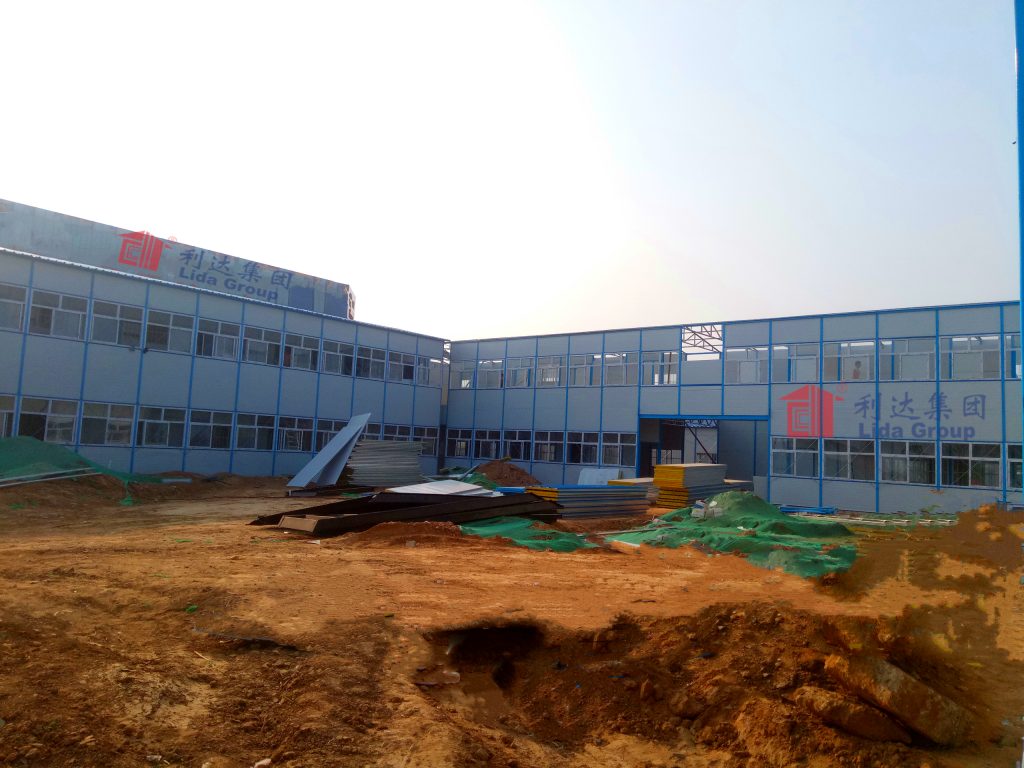
5. Case Studies: Successful Adoption in Refugee Camps
5.1 Camp in Sub-Saharan Africa
A large refugee camp in Sub-Saharan Africa, which had been struggling with overcrowding and poor shelter conditions, decided to adopt Lida Group’s prefab buildings. The camp, home to tens of thousands of refugees displaced by conflict, had previously relied on tents that were constantly damaged by heavy rains and strong winds.
After the installation of Lida Group’s mobile houses, the health of the refugees improved significantly. The incidence of waterborne diseases dropped by over 50% due to the improved sanitation facilities and drainage systems. The durable buildings withstood several severe storms, providing a safe haven for the inhabitants.
The modular design allowed for the creation of a school and a medical clinic within the camp. Attendance at the school increased, and the clinic was able to provide better healthcare services, including vaccinations and treatment for common illnesses. The refugees reported a greater sense of security and dignity, with many stating that the new shelters felt like “real homes.”
5.2 Camp in the Middle East
In a refugee camp in the Middle East, where temperatures often reach extreme highs during the summer and drop below freezing in winter, Lida Group’s insulated prefab buildings proved to be a game-changer. The traditional tents in the camp had made it nearly impossible for refugees to live comfortably in such harsh conditions, leading to a high rate of heatstroke and hypothermia.
The installation of Lida Group’s buildings, with their excellent thermal insulation, resulted in a significant improvement in the living environment. The interior temperatures remained moderate throughout the year, reducing the need for additional cooling or heating. The refugees were able to sleep better, work on small income-generating activities, and care for their families more effectively.
The inclusion of electrical wiring allowed for the use of fans and heaters when necessary, as well as lighting for evening activities. The camp also set up a small community center using the modules, where refugees could gather for cultural events and skill-building workshops, fostering a sense of community and hope.
5.3 Camp in Southeast Asia
A refugee camp in Southeast Asia, which had been affected by frequent flooding, turned to Lida Group’s prefab buildings to address the issue of water damage and mold in traditional shelters. The floodwaters often submerged the tents, destroying belongings and making the living conditions unbearable.
Lida Group’s buildings were installed on raised platforms, protecting them from flooding. The water-resistant materials and proper drainage systems prevented water from entering the units, keeping the interior dry and mold-free. This led to a marked reduction in respiratory illnesses among the refugees.
The modular design allowed for the quick expansion of the camp when more refugees arrived, ensuring that everyone had access to a safe shelter. The camp also used some of the modules as storage facilities for food and medical supplies, protecting them from water damage and ensuring their availability during emergencies.
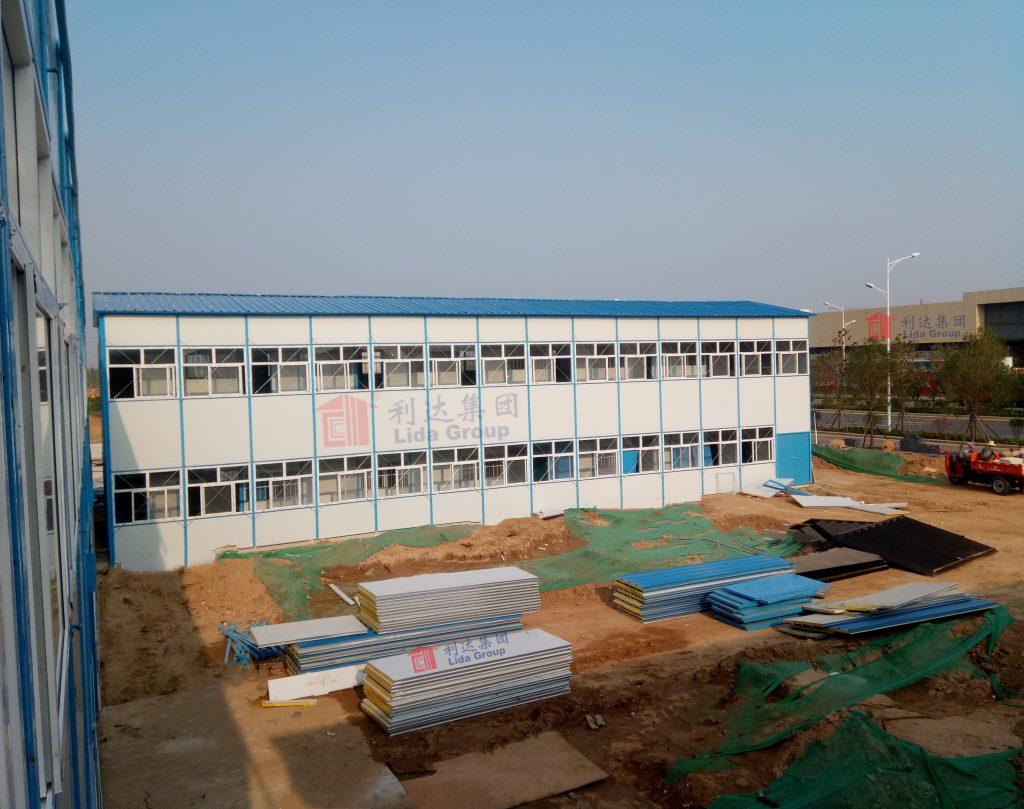
6. Environmental Considerations
6.1 Sustainable Materials and Construction
Lida Group is committed to using sustainable materials in the production of its prefab buildings. The steel frames are often made from recycled materials, and the insulation used in the sandwich panels is environmentally friendly. The manufacturing process is designed to minimize waste, with any leftover materials being recycled or reused.
The prefabricated construction method also reduces the environmental impact compared to traditional on-site construction. Since the modules are built in a factory, there is less noise, dust, and pollution at the camp site, minimizing disruption to the local ecosystem.
6.2 Energy Efficiency
The insulated sandwich panels used in Lida Group’s buildings are highly energy-efficient, reducing the need for artificial heating and cooling. This not only lowers energy costs but also reduces the carbon footprint of the refugee camp. In camps where renewable energy sources such as solar panels are available, the energy efficiency of the buildings allows for more effective use of these resources.
Some of Lida Group’s models are also designed to maximize natural light and ventilation, further reducing the need for electricity. This helps to create a more sustainable living environment that is less dependent on non-renewable energy sources.
6.3 Reusability and Recyclability
At the end of their lifespan in a refugee camp, Lida Group’s prefab buildings can be disassembled and reused in other locations. The modules are designed to be easily transported and reassembled, making them a flexible and sustainable shelter solution. This reusability reduces the amount of waste generated and minimizes the need for new materials, contributing to a circular economy.
If the buildings can no longer be reused, the materials are recyclable. The steel frames and metal panels can be recycled, reducing the environmental impact of disposal. This commitment to reusability and recyclability aligns with the global efforts to promote sustainable development and reduce waste.
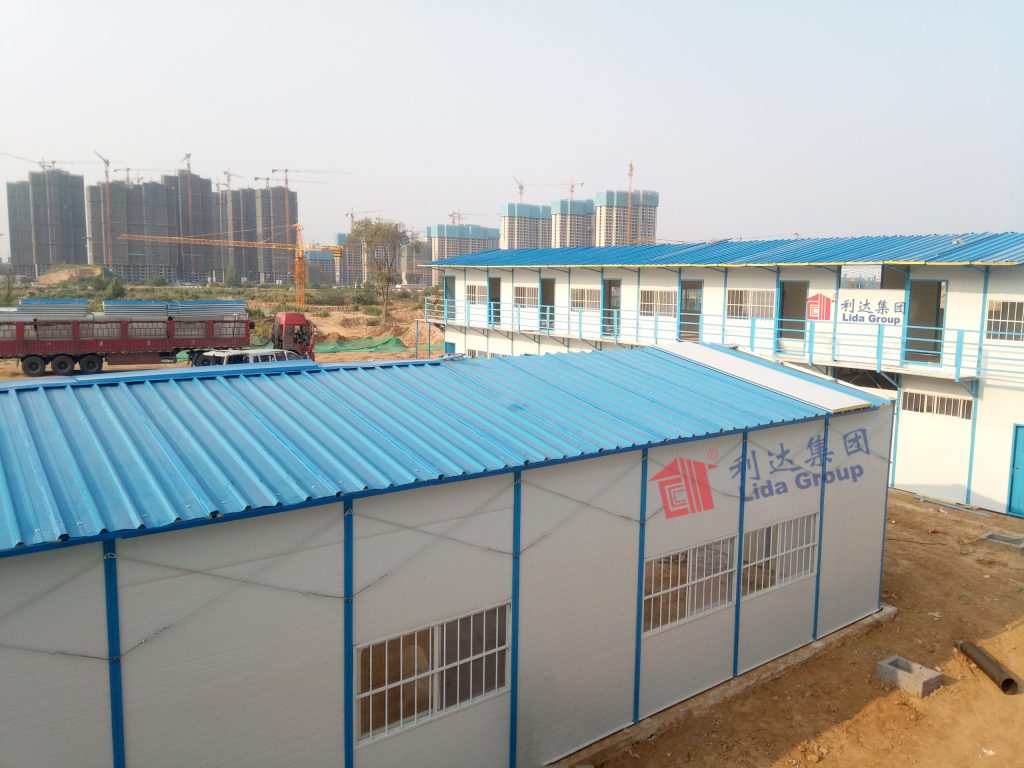
7. Challenges and Solutions in Implementation
7.1 Funding Constraints
One of the main challenges in adopting Lida Group’s prefab buildings in refugee camps is the initial cost. Many aid organizations operate on limited budgets, making it difficult to invest in more expensive shelter solutions, even if they offer long-term cost savings.
To address this, Lida Group has worked with international organizations and governments to develop flexible financing options. This includes leasing arrangements, where the cost is spread out over time, and partnerships with donors to secure funding for large-scale projects. Additionally, the long-term cost savings of the buildings, due to their durability and low maintenance, make them a more cost-effective option in the long run, which is increasingly being recognized by aid organizations.
7.2 Logistics and Transportation to Remote Areas
Refugee camps are often located in remote and hard-to-reach areas, making the transportation of prefab modules challenging. Poor road infrastructure, lack of access to ports or airports, and difficult terrain can all delay the delivery of materials.
Lida Group has addressed this by optimizing the design of its modules for easy transportation. The modules are lightweight and can be stacked, allowing for efficient loading onto trucks, ships, or planes. The company also works with local logistics partners who have knowledge of the local terrain and transportation networks, ensuring that the modules are delivered to the camp site on time. In some cases, the modules are pre-assembled as much as possible in nearby facilities to reduce the on-site installation time.
7.3 Cultural Adaptation and Local Acceptance
Refugee populations have diverse cultural backgrounds and preferences, and it is important that the shelter solutions meet their cultural needs. Lida Group’s prefab buildings may need to be adapted to accommodate specific cultural practices, such as the need for separate living areas for extended families or specific cooking facilities.
To ensure local acceptance, Lida Group works closely with local communities, aid organizations, and cultural experts to understand the specific needs and preferences of the refugees. The modular design allows for customization, enabling the company to modify the layout and features of the buildings to align with cultural practices. This collaboration helps to ensure that the shelters are not only functional but also culturally appropriate, increasing their acceptance and use by the refugee population.
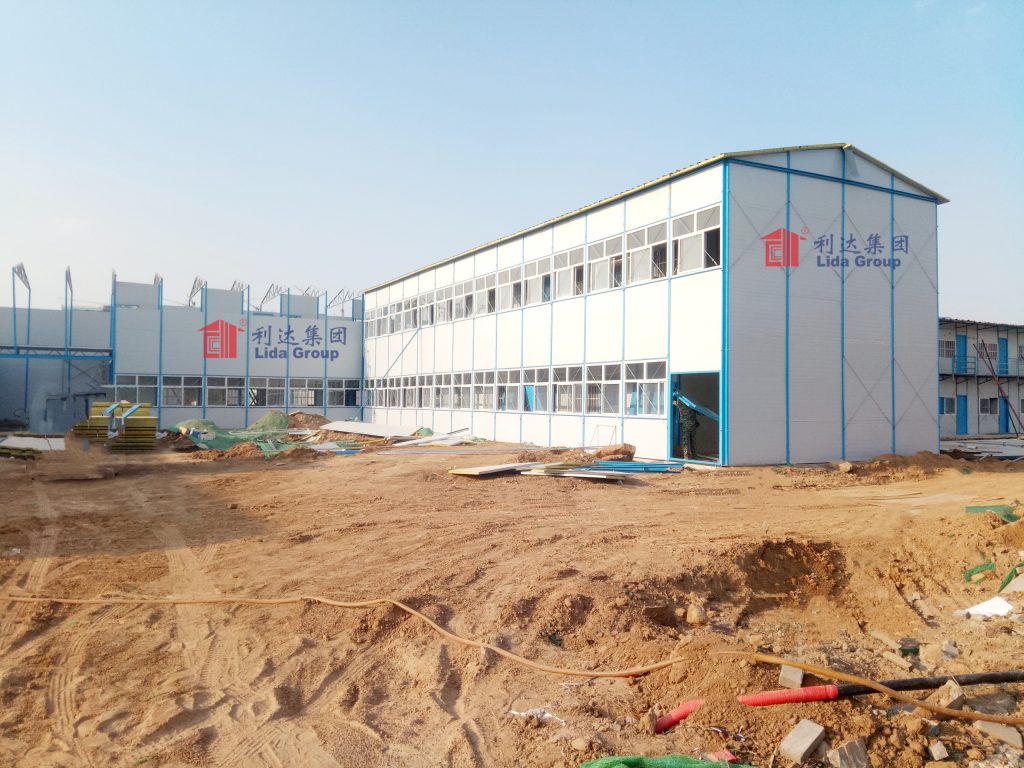
8. The Future of Refugee Shelter: Lida Group’s Role
8.1 Continuous Innovation in Design and Technology
Lida Group is constantly investing in research and development to improve its prefab buildings. The company is exploring new materials that offer even better insulation, durability, and sustainability. It is also working on integrating smart technologies into the buildings, such as solar-powered lighting and ventilation systems, to further enhance their energy efficiency and functionality.
The company is also developing more compact and lightweight modules that are easier to transport and install, making them suitable for even the most remote and challenging environments. These innovations will continue to improve the quality and effectiveness of Lida Group’s shelter solutions, ensuring that they remain at the forefront of refugee shelter provision.
8.2 Scaling Up to Meet Global Demand
As the number of refugees worldwide continues to grow, there is an increasing need for scalable shelter solutions. Lida Group is expanding its production capacity to meet this demand, with plans to build additional manufacturing facilities in strategic locations around the world. This will allow the company to produce and deliver prefab modules more quickly and efficiently, ensuring that they are available when and where they are needed most.
The company is also forging partnerships with more aid organizations, governments, and international bodies to increase the adoption of its shelter solutions on a global scale. By working together, these stakeholders can ensure that more refugee camps have access to high-quality, durable, and sustainable shelter.
8.3 Advocacy for Better Shelter Standards
Lida Group is not only providing shelter solutions but also advocating for better shelter standards in refugee camps. The company works with international organizations and policymakers to promote the adoption of guidelines and regulations that ensure refugee shelters meet basic standards of safety, comfort, and dignity.
By sharing its expertise and success stories, Lida Group is helping to raise awareness of the importance of high-quality shelter in supporting the well-being and resilience of refugee populations. This advocacy work is crucial in driving systemic change and ensuring that shelter is recognized as a fundamental right for all refugees.
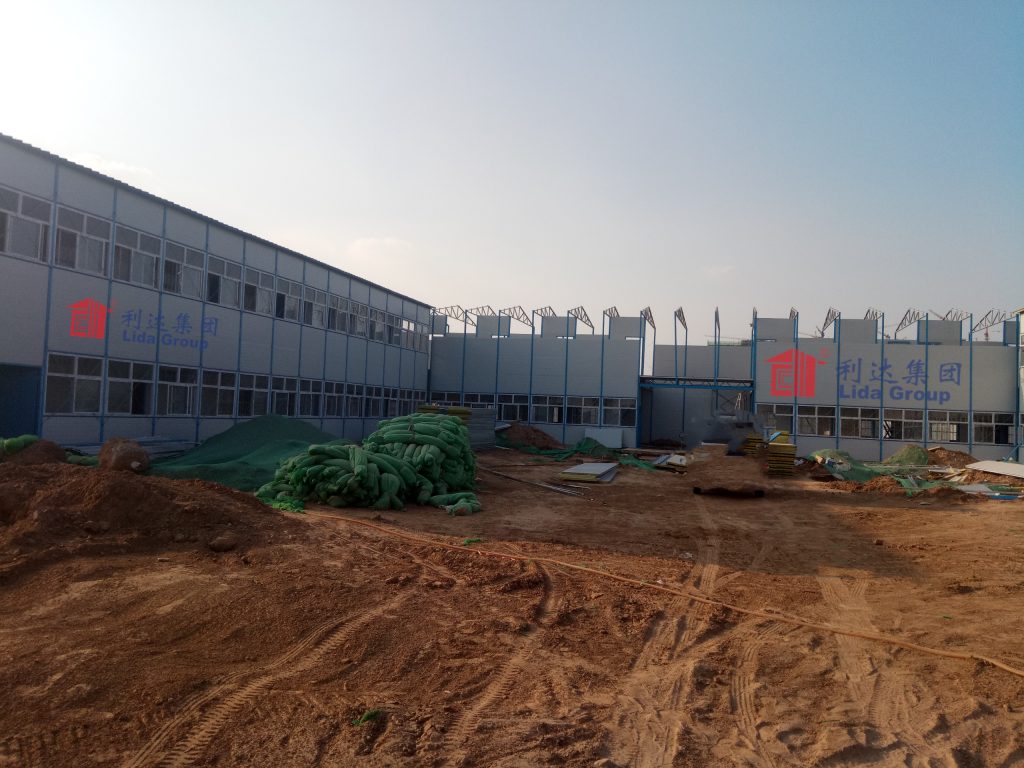
9. Conclusion
The adoption of Lida Group’s durable temporary prefab buildings with high-quality mobile house amenities in refugee camps is a testament to the effectiveness of these solutions in addressing the long-standing shelter challenges faced by displaced populations. The robust construction, modular design, integration of essential amenities, and focus on sustainability make these buildings a superior alternative to traditional shelter options.
The benefits are clear: improved health and safety, enhanced dignity and quality of life, long-term cost-effect
iveness, and support for community development. Through successful case studies in Sub-Saharan Africa, the Middle East, and Southeast Asia, we have seen firsthand how these buildings transform refugee camps from places of hardship into more stable and hopeful communities.
The environmental considerations embedded in Lida Group’s approach, such as the use of sustainable materials, energy efficiency, and reusability, align with the global push for more responsible and eco-friendly solutions, ensuring that shelter provision does not come at the expense of the planet.
While challenges like funding constraints, logistics, and cultural adaptation exist, Lida Group has demonstrated a commitment to overcoming these through innovative financing, optimized transportation, and community collaboration. The company’s focus on continuous innovation, scaling up production, and advocating for better shelter standards positions it as a key player in shaping the future of refugee shelter.
In a world where the number of displaced people continues to rise, the adoption of Lida Group’s durable temporary prefab buildings represents a crucial step forward in ensuring that refugees have access to safe, dignified, and functional shelter. These buildings are not just structures; they are tools for restoring hope, preserving dignity, and laying the foundation for a better future for some of the world’s most vulnerable populations. As more refugee camps embrace these solutions, we can look forward to a more compassionate and effective approach to addressing the global refugee crisis.
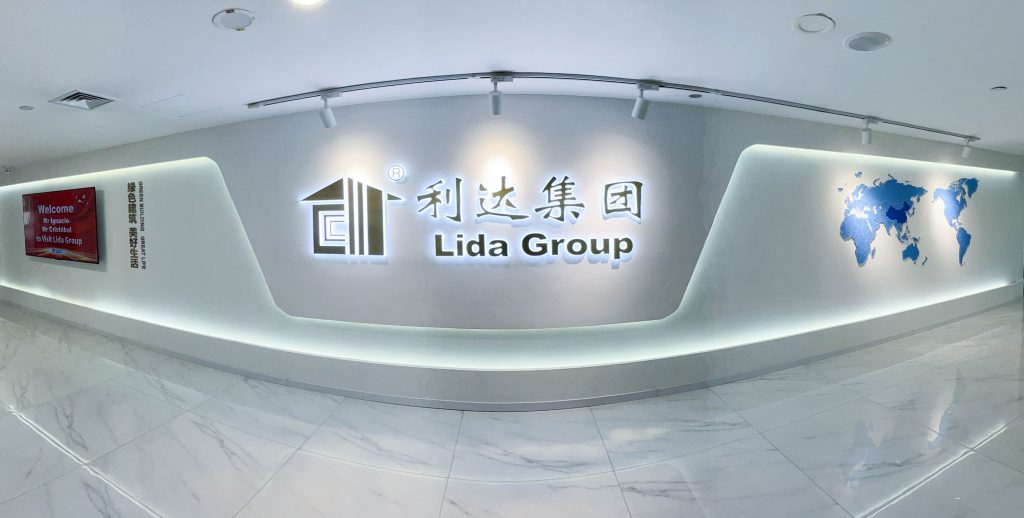
Related news
-
Film Set Revolution: High Quality Mobile House Villages Deployed via Lida Group's Temporary Prefab Sandwich Panel Systems
2025-08-06 09:58:13
-
Arctic-Grade Innovation: Temporary Prefab Buildings Feature Lida Group's Insulated Sandwich Panels for Extreme Mobile Housing
2025-08-05 17:50:41
-
Lida Group Transforms Disaster Response with High Quality Mobile Houses Using Rapid Prefab Sandwich Panel Construction
2025-08-05 15:50:25
contact us
- Tel: +86-532-88966982
- Whatsapp: +86-13793209022
- E-mail: sales@lidajituan.com


